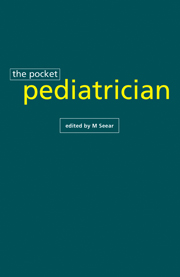Book contents
- Frontmatter
- Contents
- Analytical contents list
- Preface
- 1 Cardiology
- 2 Death and dying
- 3 Emergencies
- 4 Endocrinology
- 5 Fluids and electrolytes
- 6 Gastroenterology
- 7 General surgery
- 8 Health care ethics
- 9 Hematology
- 10 Infectious diseases
- 11 Intensive care and continuous infusion drugs
- 12 Medical genetics
- 13 Neonatology and neonatal drug dosage guidelines
- 14 Neurology
- 15 Nutrition
- 16 Oncology
- 17 Pediatric transport
- 18 Pharmacology and drug dosage guidelines
- 19 Renal
- 20 Resident fellow training
- 21 Respirology
- 22 Rheumatology
- 23 Transfusion medicine
- 24 Appendix
- Index
17 - Pediatric transport
Published online by Cambridge University Press: 01 February 2010
- Frontmatter
- Contents
- Analytical contents list
- Preface
- 1 Cardiology
- 2 Death and dying
- 3 Emergencies
- 4 Endocrinology
- 5 Fluids and electrolytes
- 6 Gastroenterology
- 7 General surgery
- 8 Health care ethics
- 9 Hematology
- 10 Infectious diseases
- 11 Intensive care and continuous infusion drugs
- 12 Medical genetics
- 13 Neonatology and neonatal drug dosage guidelines
- 14 Neurology
- 15 Nutrition
- 16 Oncology
- 17 Pediatric transport
- 18 Pharmacology and drug dosage guidelines
- 19 Renal
- 20 Resident fellow training
- 21 Respirology
- 22 Rheumatology
- 23 Transfusion medicine
- 24 Appendix
- Index
Summary
INTERFACILITY TRANSPORT
Advances in technology and the delivery of medical care for critically ill neonates and children have resulted in reduced morbidity and mortality and necessitated the development of regionalized neonatal and pediatric intensive care units. Regionalization and rationalization of specialized services have resulted in the need for transfer of the growing number of patients from the institutions where they first received care to these specialised units. Increasingly, this interfacility transfer of patients is managed by transport teams because of the recognition that critically ill and injured children can be extremely vulnerable during interhospital transfers. Transport programs vary considerably, depending on local geography, logistics, and population. However, the priorities for transport teams in different locations are often similar and standard of care has been established to enable the majority of these infants and children to be transported without harm from the inherent risks of the transport process itself.
The safe transport of a child is complicated and requires good communication between the referring and receiving physicians. Stabilization at the referring hospital is important so that the condition of the patient remains as stable as possible during the transfer and no preventable deterioration occurs. Each transport should be coordinated by a transport team director who is experienced in all aspects of transport and responsible for all major decisions regarding interfacility transport.
For continuity of care and safe transfer between one hospital and another, a clear cut sequence of events must occur.
- Type
- Chapter
- Information
- The Pocket PediatricianThe BC Children's Hospital Manual, pp. 411 - 419Publisher: Cambridge University PressPrint publication year: 1996

